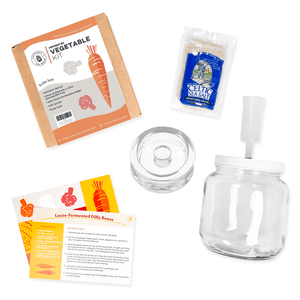
Most of the cultures throughout history, who have relied heavily on grains and legumes as staples of their diet, discovered that through fermentation they could rely on these hard-to-digest foods for nutrients. The fermentation process helps to mitigate anti-nutrients as well as increasing the bioavailability of the vitamins, minerals, and macronutrients found in these seeds. So it is no surprise that in India, where much of the population is vegetarian, these dosas are made through a process of fermentation.
30 minutes
48 minutes
4
INGREDIENTS AND EQUIPMENT AVAILABLE AT CULTURES FOR HEALTH
Fermented Vegetable Kit

Fermented Vegetable Kit
$35.99
Make tasty fermented veggies at home with our DIY Fermented Vegetable Kit!
This kit is also great for making kimchi, sauerkraut, and more! Equipment in the kit may appear different than pictured.
Dosas are a thin pancake, much like a crepe or tortilla, generally made using a combination of rice and lentils. As is the case with most traditional foods, each home or region makes theirs just a bit differently. Sometimes that difference is found in the type of rice or lentils used; other times it is the ratio of the two ingredients that is different. In either case, many people will tell you that a few things are crucial in making good dosas: Use good-quality rice and lentils that you can be sure are not very old. Add fenugreek seeds to the batter to assist in catching the wild yeasts. Use an onion half or quarter to “grease” the pan. This helps with creating a non-stick surface to cook the dosas, but also adds a bit of flavor. Use 1/2 teaspoon of salt for every 1 cup of dry ingredients. Here is one recipe that you could use to make dosas. Remember that it can be made in myriad ways, with various combinations of rice or lentils, and perhaps experimenting with other bean-grain combinations. The process seems quite extensive, but remember that this is a
traditional dish made frequently by those who had no modern conveniences.

INGREDIENTS:
- 2 cups rice
- 2 cups lentils
- 1 tsp. fenugreek seeds
- 2 tsp. sea salt, plus more to taste
- Water as needed
INSTRUCTIONS:
- Soak rice in a medium vessel, covered with water by a couple of inches, for 6 to 8 hours. In another container, simultaneously soak lentils and fenugreek seeds, covered with water by at least 3 inches, for 6 to 8 hours.
- After the soaking process is complete, drain and rinse rice and lentils/fenugreek seeds separately.
- You are now going to be grinding the two elements, separately to achieve the right consistency, in a food processor or blender.
- Start by adding a couple of tablespoons of water to the grinder, followed by a handful of the lentils. Grind until fluffy and smooth, much like marshmallow fluff, in small batches adding handfuls of lentils and a couple of tablespoons of water at a time. This may take 15 minutes or so. Transfer lentil batter to a separate, very large vessel being careful not to remove too much air from the batter.
- Repeat with rice, but this time aim for a slightly gritty batter as opposed to the smooth batter of the lentils. Start by adding one cup of water to the machine then handfuls of rice at a time, with additional water to facilitate the grinding of the rice. This may take 20 or so minutes.
- Carefully transfer rice batter to the vessel containing lentil batter, again being careful not to remove air trapped in batter. Add salt and carefully mix the two batters with a clean hand or large spoon. Taste and add additional salt if the batter tastes flat. Be sure that the vessel has room for the batter to double in size. If not, pour half the batter into a separate vessel to allow room for expansion.
- Cover with a breathable lid such as a clean towel and secure to keep fruit flies out. Place in a warm spot such as an oven with a pilot light on, or atop a warm refrigerator.
- Ferment for 12 to 48 hours, depending on the temperature, or until batter appears to have doubled.
- Once fermented, the dough should be frothy and of pouring consistency, but not runny. If it is not of pouring consistency, add a little bit of water and stir very gently, being sure not to deflate dough.
- Preheat a 10-inch cast-iron skillet over high heat and allow the pan to heat up. Once you feel warmth coming off of it when you place a hand just above the bottom of the pan, test it by sprinkling a few drops of water on the bottom of the pan. If the water evaporates within 4 seconds it is ready.
- Oil half of a small onion on the cut side. Stab onion with a fork and move onion all around skillet to oil the pan.
- Ladle 1/4 cup of batter into the hot pan. With as little pressure as possible, use the back of your (metal) ladle to swirl the batter in concentric circles to fill the pan.
- When the batter is spread, drizzle a few drops of olive oil over the dosa in the pan.
- Cook over medium-high heat until the bottom is lightly brown. Now roll or fold the dosa out of the pan. There is no need to cook the other side unless you like a crisper dosa.
-
Serve with Indian chutney, curry, or a bean dish.













